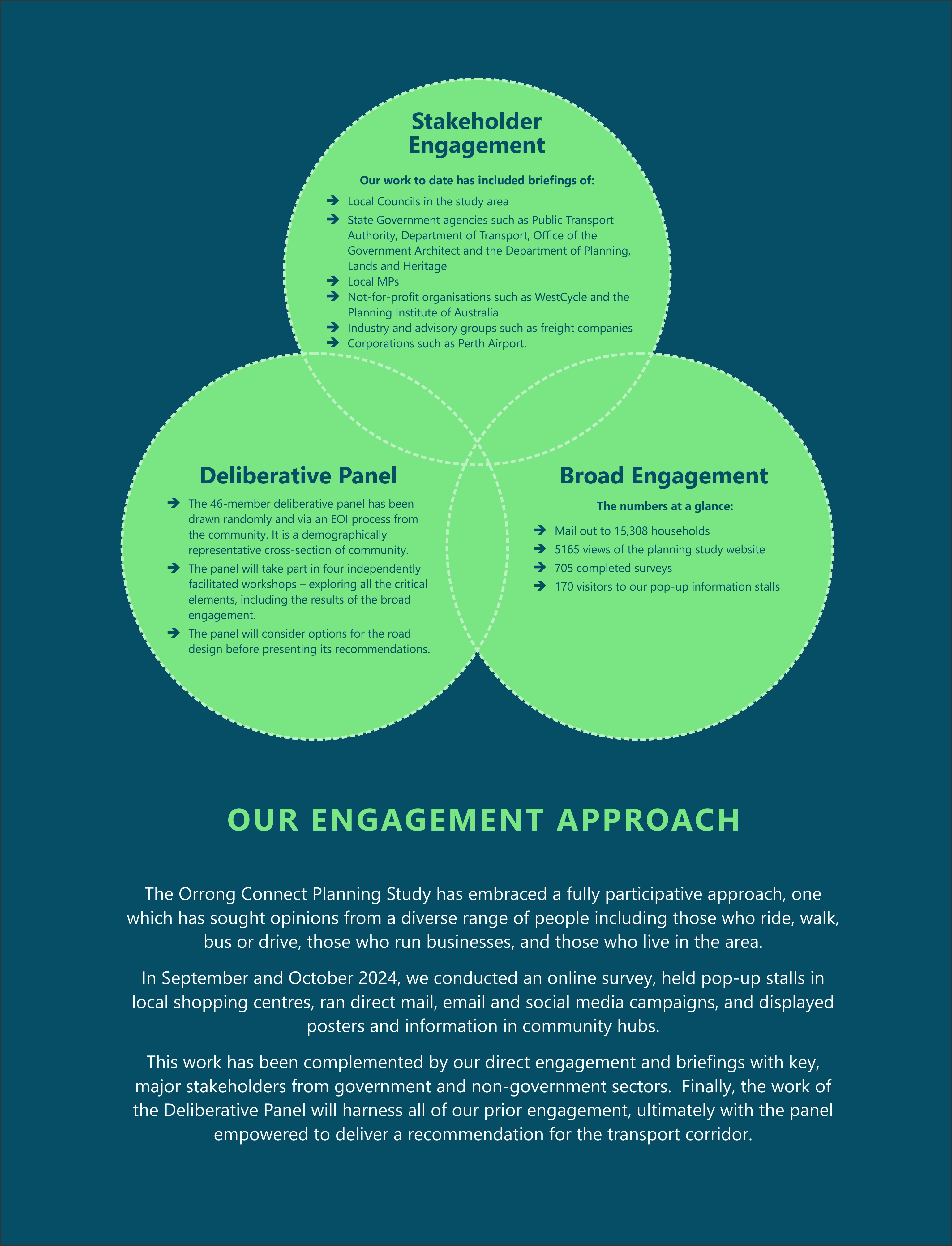About Orrong Connect
Since Graham Farmer Freeway opened, traffic volumes on Orrong Road have increased significantly. It often operates at capacity, with up to 65,000 vehicles per day carrying around 85,000 people.
Congestion along Orrong Road/Graham Farmer Freeway costs our local economy up to $49.5 million every year in lost productivity. Congestion on this stretch of road is expected to increase as population and traffic volumes continue to grow.
In 2019, Main Roads undertook a planning study which proposed a design which featured a lowered expressway between Leach Highway and Great Eastern Highway. The design allowed traffic to travel unimpeded by signalised intersections. Local road connections were maintained by constructing surface roads over the expressway at designated intersections.
Several options were considered to determine the proposed design and public consultation on the preferred concept was undertaken during 2019.
The 2019 planning study was a long-term plan, designed to improve safety by eliminating conflict between regional and local traffic, but included impacts to adjacent properties along the corridor.
The Western Australia Planning Commission supported the 2019 concept and a Planning Control Area (PCA) was put in place to protect the proposed road corridor.
To view more information view PCA 183.
We are looking to work with community and stakeholders to consider a broader range of options, including the lowered expressway proposed in 2019, through a more participative community engagement process which will incorporate a diverse range of people and a place-based approach to road design.
Our engagement process
Orrong Connect is committed to a robust and comprehensive engagement process to deliver the best possible outcomes for Orrong Road and its surrounding communities.
With community, industry, and other important stakeholders we want to consider a broad range of issues and solutions.
The range of opinions being canvassed will help us deliver a transport solution that can improve safety, reduce congestion and enhance connectivity and liveability for people who travel along or live near this key transport route.
Since September 2024, we’ve met with and talked to many hundreds of people, who have helped us identify what people want from this planning study. This consultation has been key in our process and will continue throughout the remainder of the planning study to help us achieve great outcomes.

Engagement objectives and principles
Our approach to communications and stakeholder engagement is anchored by a set of principles defined at an organisational level and applied across all Main Roads projects.
The overarching objectives of the engagement process are:
- Relationships with stakeholders and the community are built through timely and open communication. Commitments throughout the project are followed through efficiently and effectively.
- Processes are designed to allow for difference and a diverse range of stakeholder and community members to participate.
- Input from engagement activities are recorded and incorporated into the final decision to the maximum extent possible. Decisions deliver a high value to the public.
- Systems, culture and decision-making supports quality engagement planning, delivery, evaluation and continuous improvement.
- Appropriate time, finances and people are allocated to the project to manage engagement activities and ensure quality outcomes.
Our guiding engagement principles are:
| POSITIVITY | We believe in the work being undertaken by Main Roads and advocate its benefits to the community. |
| ACCURACY | We make sure our information is factually and technically correct at all times (to the best of our understanding). |
| CURRENCY | We check our information is up-to-date and current. |
| CONSISTENCY | We use approved key messaging and narratives across all our communications, adapted when / as needed but taking care not to contradict what we’ve said previously (other than to correct misinformation when and if we become aware of it). |
| TRANSPARENCY | We are honest in our communications, acknowledging our successes and our failures, including taking responsibility for any actions that result in negative impacts. |
| EMPATHY | We use emotive language that displays empathy, understanding and sympathy, putting ourselves in the shoes of those we are communicating with and being sensitive to cultural issues. |
| SHOW RATHER THAN TELL | We use images, videos, animations, and on-camera interviews wherever possible to inform and educate. |
| TWO-WAY COMMUNICATION | We ensure our communication is two-way, with opportunities and mechanisms for our customers to provide feedback as part of business as usual. We make sure their feedback reaches those who need to know, acknowledging and acting upon it where appropriate and ‘closing the loop’ with our customers so they know they’ve been heard. |
| TIMELY | Our timelines for communications are based on our customers’ needs, ensuring information is delivered to our target audiences as soon as is practicable and, at the very least, in time for them to act on our advice if action is required. |
Read what our stakeholders have had to say
- WA Transport Magazine - Facebook Post
- Planning Institute of Australia - LinkedIn Post
- WestCycle - Can We Make Orrong Orright? - WestCycle Article
2019 Project Publications
- YouTube: Orrong Road future concept – 2019
- 2019 Engagement Summary - March 2020
- 2019 Consultation
Note: The above documents will help inform the current engagement but the panel’s work will explore various options before arriving at an agreed concept design.